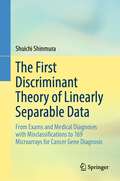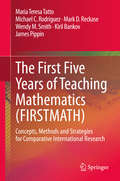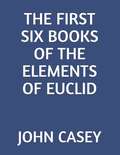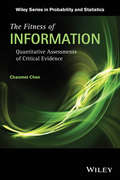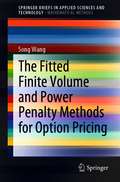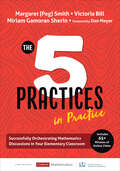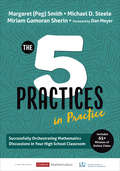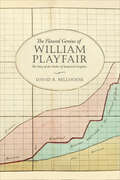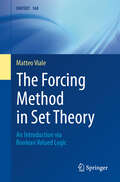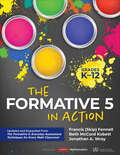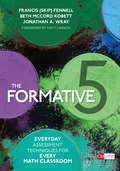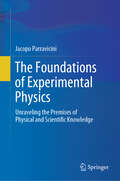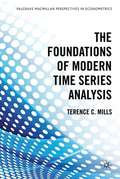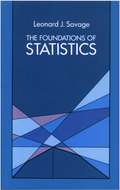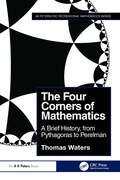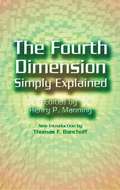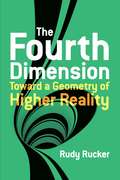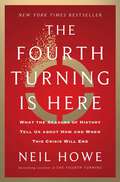- Table View
- List View
The First Discriminant Theory of Linearly Separable Data: From Exams and Medical Diagnoses with Misclassifications to 169 Microarrays for Cancer Gene Diagnosis
by Shuichi ShinmuraThis book deals with the first discriminant theory of linearly separable data (LSD), Theory3, based on the four ordinary LSD of Theory1 and 169 microarrays (LSD) of Theory2. Furthermore, you can quickly analyze the medical data with the misclassified patients which is the true purpose of diagnoses. Author developed RIP (Optimal-linear discriminant function finding the combinatorial optimal solution) as Theory1 in decades ago, that found the minimum misclassifications. RIP discriminated 63 (=26−1) models of Swiss banknote (200*6) and found the minimum LSD: basic gene set (BGS). In Theory2, RIP discriminated Shipp microarray (77*7129) which was LSD and had only 32 nonzero coefficients (first Small Matryoshka; SM1). Because RIP discriminated another 7,097 genes and found SM2, the author developed the Matryoshka feature selection Method 2 (Program 3), that splits microarray into many SMs. Program4 can split microarray into many BGSs. Then, the wide columnLSD (Revolution-0), such as microarray (n Theory3 shows the surprising results of six ordinary data re-analyzed by Theory1 and Theory2 knowledge. Essence of Theory3 is described by using cephalopelvic disproportion (CPD) data. RIP discriminates CPD data (240*19) and finds two misclassifications unique for cesarean and natural-born groups. CPD238 omitting two patients becomes LSD, which is the first case selection method. Program4 finds BGS (14 vars.) the only variable selection method for Theory3. 32 (=25) models, including BGS, become LSD among (219−1) models. Because Program2 confirms BGS has the minimum average error rate, BGS is the most compact and best model satisfying Occam’s Razor. With this book, physicians obtain complete diagnostic results for disease, and engineers can become a true data scientist, by obtaining integral knowledge ofstatistics and mathematical programming with simple programs.
The First Five Years of Teaching Mathematics (FIRSTMATH): Concepts, Methods and Strategies for Comparative International Research
by Maria Teresa Tatto Michael C. Rodriguez Wendy M. Smith Mark D. Reckase Kiril Bankov James PippinThis book reports on an innovative study into the first five years of mathematics teaching: FIRSTMATH. For the first time, the study has developed a viable methodology to analyze the knowledge, skills, and dispositions of beginning mathematics teachers as well as instruments to explore the contexts where they work. The book provides a step by step account of this exploratory (proof-of-concept) research study, using a comparative and international approach, and introduces readers to the challenges entailed.The FIRSTMATH study promises the development of methods and strategies to make it possible for teacher educators and future teachers to examine (and improve on) their own practices in an important STEM area.
The First Six Books of the Elements of Euclid: With Notes
by John Casey EuclidThe First Six Books of the Elements of Euclid With Notes by John Casey and Euclid
The Fitness of Information
by Chaomei ChenTheories and practices to assess critical information in a complex adaptive system Organized for readers to follow along easily, The Fitness of Information: Quantitative Assessments of Critical Evidence provides a structured outline of the key challenges in assessing crucial information in a complex adaptive system. Illustrating a variety of computational and explanatory challenges, the book demonstrates principles and practical implications of exploring and assessing the fitness of information in an extensible framework of adaptive landscapes. The book's first three chapters introduce fundamental principles and practical examples in connection to the nature of aesthetics, mental models, and the subjectivity of evidence. In particular, the underlying question is how these issues can be addressed quantitatively, not only computationally but also explanatorily. The next chapter illustrates how one can reduce the level of complexity in understanding the structure and dynamics of scientific knowledge through the design and use of the CiteSpace system for visualizing and analyzing emerging trends in scientific literature. The following two chapters explain the concepts of structural variation and the fitness of information in a framework that builds on the idea of fitness landscape originally introduced to study population evolution. The final chapter presents a dual-map overlay technique and demonstrates how it supports a variety of analytic tasks for a new type of portfolio analysis. The Fitness of Information: Quantitative Assessments of Critical Evidence also features: In-depth case studies and examples that characterize far-reaching concepts, illustrate underlying principles, and demonstrate profound challenges and complexities at various levels of analytic reasoning Wide-ranging topics that underline the common theme, from the subjectivity of evidence in criminal trials to detecting early signs of critical transitions and mechanisms behind radical patents An extensible and unifying framework for visual analytics by transforming analytic reasoning tasks to the assessment of critical evidence The Fitness of Information: Quantitative Assessments of Critical Evidence is a suitable reference for researchers, analysts, and practitioners who are interested in analyzing evidence and making decisions with incomplete, uncertain, and even conflicting information. The book is also an excellent textbook for upper-undergraduate and graduate-level courses on visual analytics, information visualization, and business analytics and decision support systems.
The Fitted Finite Volume and Power Penalty Methods for Option Pricing (SpringerBriefs in Applied Sciences and Technology)
by Song WangThis book contains mostly the author’s up-to-date research results in the area. Option pricing has attracted much attention in the past decade from applied mathematicians, statisticians, practitioners and educators. Many partial differential equation-based theoretical models have been developed for valuing various options. These models do not have any practical use unless their solutions can be found. However, most of these models are far too complex to solve analytically and numerical approximations have to be sought in practice. The contents of the book consist of three parts: (i) basic theory of stochastic control and formulation of various option pricing models, (ii) design of finite volume, finite difference and penalty-based algorithms for solving the models and (iii) stability and convergence analysis of the algorithms. It also contains extensive numerical experiments demonstrating how these algorithms perform for practical problems. The theoretical and numerical results demonstrate these algorithms provide efficient, accurate and easy-to-implement numerical tools for financial engineers to price options. This book is appealing to researchers in financial engineering, optimal control and operations research. Financial engineers and practitioners will also find the book helpful in practice.
The Five Practices in Practice [Elementary]: Successfully Orchestrating Mathematics Discussions in Your Elementary Classroom (Corwin Mathematics Series)
by Margaret (Peg) Smith Miriam Gamoran Sherin Victoria L. Bill"Neither a love of students nor a love of mathematics can sustain the work of math education on its own. We work with math students, a composite of their mathematical ideas and their identities as people. The five practices for orchestrating productive mathematical discussions, and these ideas for putting those practices into practice, offer the actions that can develop and sustain the belief that both math and students matter." From the Foreword by Dan Meyer, Chief Academic Officer, Desmos Take a deeper dive into understanding the five practices—anticipating, monitoring, selecting, sequencing, and connecting—for facilitating productive mathematical conversations in your elementary classrooms and learn to apply them with confidence. This follow-up to the modern classic, Five Practices for Orchestrating Productive Mathematics Discussions, shows the five practices in action in Grades K-5 classrooms and empowers teachers to be prepared for and overcome the challenges common to orchestrating math discussions. The chapters unpack the five practices and guide teachers to a deeper understanding of how to use each practice effectively in an inquiry-oriented classroom. This book will help you launch meaningful mathematical discussion through • Key questions to set learning goals, identify high-level tasks, anticipate student responses, and develop targeted assessing and advancing questions that jumpstart productive discussion—before class begins • Video excerpts from real elementary classrooms that vividly illustrate the five practices in action and include built-in opportunities for you to consider effective ways to monitor students’ ideas, and successful approaches for selecting, sequencing, and connecting students’ ideas during instruction • "Pause and Consider" prompts that help you reflect on an issue—and, in some cases, draw on your own classroom experience—prior to reading more about it • "Linking To Your Own Instruction" sections help you implement the five practices with confidence in your own instruction The book and companion website provide an array of resources including planning templates, sample lesson plans and completed monitoring tools, and mathematical tasks. Enhance your fluency in the five practices to bring powerful discussions of mathematical concepts to life in your classroom.
The Five Practices in Practice [Elementary]: Successfully Orchestrating Mathematics Discussions in Your Elementary Classroom (Corwin Mathematics Series)
by Margaret (Peg) Smith Miriam Gamoran Sherin Victoria L. Bill"Neither a love of students nor a love of mathematics can sustain the work of math education on its own. We work with math students, a composite of their mathematical ideas and their identities as people. The five practices for orchestrating productive mathematical discussions, and these ideas for putting those practices into practice, offer the actions that can develop and sustain the belief that both math and students matter." From the Foreword by Dan Meyer, Chief Academic Officer, Desmos Take a deeper dive into understanding the five practices—anticipating, monitoring, selecting, sequencing, and connecting—for facilitating productive mathematical conversations in your elementary classrooms and learn to apply them with confidence. This follow-up to the modern classic, Five Practices for Orchestrating Productive Mathematics Discussions, shows the five practices in action in Grades K-5 classrooms and empowers teachers to be prepared for and overcome the challenges common to orchestrating math discussions. The chapters unpack the five practices and guide teachers to a deeper understanding of how to use each practice effectively in an inquiry-oriented classroom. This book will help you launch meaningful mathematical discussion through • Key questions to set learning goals, identify high-level tasks, anticipate student responses, and develop targeted assessing and advancing questions that jumpstart productive discussion—before class begins • Video excerpts from real elementary classrooms that vividly illustrate the five practices in action and include built-in opportunities for you to consider effective ways to monitor students’ ideas, and successful approaches for selecting, sequencing, and connecting students’ ideas during instruction • "Pause and Consider" prompts that help you reflect on an issue—and, in some cases, draw on your own classroom experience—prior to reading more about it • "Linking To Your Own Instruction" sections help you implement the five practices with confidence in your own instruction The book and companion website provide an array of resources including planning templates, sample lesson plans and completed monitoring tools, and mathematical tasks. Enhance your fluency in the five practices to bring powerful discussions of mathematical concepts to life in your classroom.
The Five Practices in Practice [High School]: Successfully Orchestrating Mathematics Discussions in Your High School Classroom (Corwin Mathematics Series)
by Margaret (Peg) Smith Miriam Gamoran Sherin Michael D. Steele"This book makes the five practices accessible for high school mathematics teachers. Teachers will see themselves and their classrooms throughout the book. High school mathematics departments and teams can use this book as a framework for engaging professional collaboration. I am particularly excited that this book situates the five practices as ambitious and equitable practices." Robert Q. Berry, III NCTM President 2018-2020 Samuel Braley Gray Professor of Mathematics Education, University of Virginia Take a deeper dive into understanding the five practices—anticipating, monitoring, selecting, sequencing, and connecting—for facilitating productive mathematical conversations in your high school classrooms and learn to apply them with confidence. This follow-up to the modern classic, 5 Practices for Orchestrating Productive Mathematics Discussions, shows the five practices in action in high school classrooms and empowers teachers to be prepared for and overcome the challenges common to orchestrating math discussions. The chapters unpack the five practices and guide teachers to a deeper understanding of how to use each practice effectively in an inquiry-oriented classroom. This book will help you launch meaningful mathematical discussion through · Key questions to set learning goals, identify high-level tasks, anticipate student responses, and develop targeted assessing and advancing questions that jumpstart productive discussion—before class begins · Video excerpts from real high school classrooms that vividly illustrate the five practices in action and include built-in opportunities for you to consider effective ways to monitor students’ ideas, and successful approaches for selecting, sequencing, and connecting students’ ideas during instruction · "Pause and Consider" prompts that help you reflect on an issue—and, in some cases, draw on your own classroom experience—prior to reading more about it · "Linking To Your Own Instruction" sections help you implement the five practices with confidence in your own instruction The book and companion website provide an array of resources including planning templates, sample lesson plans, completed monitoring tools, and mathematical tasks. Enhance your fluency in the five practices to bring powerful discussions of mathematical concepts to life in your classroom.
The Five Practices in Practice [High School]: Successfully Orchestrating Mathematics Discussions in Your High School Classroom (Corwin Mathematics Series)
by Margaret (Peg) Smith Miriam Gamoran Sherin Michael D. Steele"This book makes the five practices accessible for high school mathematics teachers. Teachers will see themselves and their classrooms throughout the book. High school mathematics departments and teams can use this book as a framework for engaging professional collaboration. I am particularly excited that this book situates the five practices as ambitious and equitable practices." Robert Q. Berry, III NCTM President 2018-2020 Samuel Braley Gray Professor of Mathematics Education, University of Virginia Take a deeper dive into understanding the five practices—anticipating, monitoring, selecting, sequencing, and connecting—for facilitating productive mathematical conversations in your high school classrooms and learn to apply them with confidence. This follow-up to the modern classic, 5 Practices for Orchestrating Productive Mathematics Discussions, shows the five practices in action in high school classrooms and empowers teachers to be prepared for and overcome the challenges common to orchestrating math discussions. The chapters unpack the five practices and guide teachers to a deeper understanding of how to use each practice effectively in an inquiry-oriented classroom. This book will help you launch meaningful mathematical discussion through · Key questions to set learning goals, identify high-level tasks, anticipate student responses, and develop targeted assessing and advancing questions that jumpstart productive discussion—before class begins · Video excerpts from real high school classrooms that vividly illustrate the five practices in action and include built-in opportunities for you to consider effective ways to monitor students’ ideas, and successful approaches for selecting, sequencing, and connecting students’ ideas during instruction · "Pause and Consider" prompts that help you reflect on an issue—and, in some cases, draw on your own classroom experience—prior to reading more about it · "Linking To Your Own Instruction" sections help you implement the five practices with confidence in your own instruction The book and companion website provide an array of resources including planning templates, sample lesson plans, completed monitoring tools, and mathematical tasks. Enhance your fluency in the five practices to bring powerful discussions of mathematical concepts to life in your classroom.
The Five Practices in Practice [Middle School]: Successfully Orchestrating Mathematics Discussions in Your Middle School Classroom (Corwin Mathematics Series)
by Margaret (Peg) Smith Miriam Gamoran SherinTake a deep dive into the five practices for facilitating productive mathematical discussions Take a deeper dive into understanding the five practices—anticipating, monitoring, selecting, sequencing, and connecting—for facilitating productive mathematical conversations in your middle school classrooms and learn to apply them with confidence. This follow-up to the modern classic, Five Practices for Orchestrating Productive Mathematics Discussions, shows the five practices in action in middle school classrooms and empowers teachers to be prepared for and overcome the challenges common to orchestrating math discussions. The chapters unpack the five practices and guide teachers to a deeper understanding of how to use each practice effectively in an inquiry-oriented classroom. This book will help you launch meaningful mathematical discussion through Key questions to set learning goals, identify high-level tasks, anticipate student responses, and develop targeted assessing and advancing questions that jumpstart productive discussion—before class begins Video excerpts from real middle school classrooms that vividly illustrate the five practices in action and include built-in opportunities for you to consider effective ways to monitor students’ ideas, and successful approaches for selecting, sequencing, and connecting students’ ideas during instruction "Pause and Consider" prompts that help you reflect on an issue—and, in some cases, draw on your own classroom experience—prior to reading more about it "Linking To Your Own Instruction" sections help you implement the five practices with confidence in your own instruction The book and companion website provide an array of resources including planning templates, sample lesson plans and completed monitoring tools, and mathematical tasks. Enhance your fluency in the five practices to bring powerful discussions of mathematical concepts to life in your classroom. "This books takes 5 Practices for Orchestrating Productive Mathematics Discussions to the next level as readers experience what these practices look like in real mathematics classrooms in middle school. The authors specifically address the challenges one might face in implementing the classrooms by providing recommendations and concrete examples to avoid these challenges. This book is a must read for teachers who want to amplify their classroom implementation of the five practices." Cathy Martin, Executive Director of Curriculum & Instruction Denver Public Schools
The Five Practices in Practice [Middle School]: Successfully Orchestrating Mathematics Discussions in Your Middle School Classroom (Corwin Mathematics Series)
by Margaret (Peg) Smith Miriam Gamoran SherinTake a deep dive into the five practices for facilitating productive mathematical discussions Take a deeper dive into understanding the five practices—anticipating, monitoring, selecting, sequencing, and connecting—for facilitating productive mathematical conversations in your middle school classrooms and learn to apply them with confidence. This follow-up to the modern classic, Five Practices for Orchestrating Productive Mathematics Discussions, shows the five practices in action in middle school classrooms and empowers teachers to be prepared for and overcome the challenges common to orchestrating math discussions. The chapters unpack the five practices and guide teachers to a deeper understanding of how to use each practice effectively in an inquiry-oriented classroom. This book will help you launch meaningful mathematical discussion through Key questions to set learning goals, identify high-level tasks, anticipate student responses, and develop targeted assessing and advancing questions that jumpstart productive discussion—before class begins Video excerpts from real middle school classrooms that vividly illustrate the five practices in action and include built-in opportunities for you to consider effective ways to monitor students’ ideas, and successful approaches for selecting, sequencing, and connecting students’ ideas during instruction "Pause and Consider" prompts that help you reflect on an issue—and, in some cases, draw on your own classroom experience—prior to reading more about it "Linking To Your Own Instruction" sections help you implement the five practices with confidence in your own instruction The book and companion website provide an array of resources including planning templates, sample lesson plans and completed monitoring tools, and mathematical tasks. Enhance your fluency in the five practices to bring powerful discussions of mathematical concepts to life in your classroom. "This books takes 5 Practices for Orchestrating Productive Mathematics Discussions to the next level as readers experience what these practices look like in real mathematics classrooms in middle school. The authors specifically address the challenges one might face in implementing the classrooms by providing recommendations and concrete examples to avoid these challenges. This book is a must read for teachers who want to amplify their classroom implementation of the five practices." Cathy Martin, Executive Director of Curriculum & Instruction Denver Public Schools
The Flawed Genius of William Playfair: The Story of the Father of Statistical Graphics
by David R. BellhouseA product of the Scottish Enlightenment, William Playfair (1759–1823) worked as a statistician, economist, engineer, banker, land speculator, scam artist, and political propagandist. It has been claimed – erroneously – that Playfair was a spy for the British government and ran a forging operation to print the paper money of the French Revolution. The Flawed Genius of William Playfair offers a complete account of Playfair’s life, richly contextualized in the economic, political, and cultural history of the French Revolution and Napoleonic Wars. The book explores the many peaks and troughs of Playfair’s career, ranging from moderate prosperity to bankruptcy and imprisonment. Through careful analysis, David R. Bellhouse shows that Playfair was neither a spy nor a forger, but perhaps briefly a one-time courier for a government minister. Bellhouse pieces together as complete a picture as possible of the forging operations supported by the British government and illuminates Playfair’s lasting contributions in economics and statistics, where he is known as the father of statistical graphics. Disputing the misinformation about the man, The Flawed Genius of William Playfair highlights that the truth about Playfair’s life is often more intriguing than the fictions that surround him.
The Forcing Method in Set Theory: An Introduction via Boolean Valued Logic (UNITEXT #168)
by Matteo VialeThe main aim of this book is to provide a compact self-contained presentation of the forcing technique devised by Cohen to establish the independence of the continuum hypothesis from the axioms of set theory. The book follows the approach to the forcing technique via Boolean valued semantics independently introduced by Vopenka and Scott/Solovay; it develops out of notes I prepared for several master courses on this and related topics and aims to provide an alternative (and more compact) account of this topic with respect to the available classical textbooks. The aim of the book is to take up a reader with familiarity with logic and set theory at the level of an undergraduate course on both topics (e.g., familiar with most of the content of introductory books on first-order logic and set theory) and bring her/him to page with the use of the forcing method to produce independence (or undecidability results) in mathematics. Familiarity of the reader with general topology would also be quite helpful; however, the book provides a compact account of all the needed results on this matter. Furthermore, the book is organized in such a way that many of its parts can also be read by scholars with almost no familiarity with first-order logic and/or set theory. The book presents the forcing method outlining, in many situations, the intersections of set theory and logic with other mathematical domains. My hope is that this book can be appreciated by scholars in set theory and by readers with a mindset oriented towards areas of mathematics other than logic and a keen interest in the foundations of mathematics.
The Formative 5 in Action, Grades K-12: Updated and Expanded From The Formative 5: Everyday Assessment Techniques for Every Math Classroom (Corwin Mathematics Series)
by Beth McCord Kobett Francis M. Fennell Jonathan A. WrayLeverage formative assessment in mathematics every single day For fans of the bestselling book The Formative 5: Everyday Assessment Techniques for Every Math Classroom comes this updated and expanded edition for understanding and implementing highly effective, research-backed formative assessment techniques into seamless, daily practice with students in grades K-12. The Formative 5 in Action serves as an interactive guide that steers teachers toward successful implementation of the formative five techniques of observation, interviews, Show Me, hinge questions, and exit tasks. This updated guidebook offers: More than 120 minutes of video examples of the five techniques in action in real K-12 classrooms, showing teachers not just what to do but how to do it An engaging format with built-in reflection exercises and activities that foster individual professional learning and promote PLC study through discussion and collaboration An explicit emphasis on providing effective and timely feedback to students while harnessing student strengths throughout teaching and learning Comprehensive responses to teachers’ frequently asked questions that have surfaced since the publication of the first book The research is clear – the authors’ five formative assessment techniques lead to greater attention to planning, stronger instruction for teachers, and better achievement for students. The Formative 5 in Action is a truly engaging resource that helps mathematics teachers and instructional leaders engage in classroom-based formative assessment with precision, intentionality, and ease.
The Formative 5 in Action, Grades K-12: Updated and Expanded From The Formative 5: Everyday Assessment Techniques for Every Math Classroom (Corwin Mathematics Series)
by Beth McCord Kobett Francis M. Fennell Jonathan A. WrayLeverage formative assessment in mathematics every single day For fans of the bestselling book The Formative 5: Everyday Assessment Techniques for Every Math Classroom comes this updated and expanded edition for understanding and implementing highly effective, research-backed formative assessment techniques into seamless, daily practice with students in grades K-12. The Formative 5 in Action serves as an interactive guide that steers teachers toward successful implementation of the formative five techniques of observation, interviews, Show Me, hinge questions, and exit tasks. This updated guidebook offers: More than 120 minutes of video examples of the five techniques in action in real K-12 classrooms, showing teachers not just what to do but how to do it An engaging format with built-in reflection exercises and activities that foster individual professional learning and promote PLC study through discussion and collaboration An explicit emphasis on providing effective and timely feedback to students while harnessing student strengths throughout teaching and learning Comprehensive responses to teachers’ frequently asked questions that have surfaced since the publication of the first book The research is clear – the authors’ five formative assessment techniques lead to greater attention to planning, stronger instruction for teachers, and better achievement for students. The Formative 5 in Action is a truly engaging resource that helps mathematics teachers and instructional leaders engage in classroom-based formative assessment with precision, intentionality, and ease.
The Formative 5: Everyday Assessment Techniques for Every Math Classroom (Corwin Mathematics Series)
by Francis Fennell Beth McCord Kobett Jon A. WrayMove the needle on math instruction with these 5 assessment techniques! Mathematics education experts Fennell, Kobett, and Wray offer five of the most impactful and proven formative assessment techniques you can implement—Observations, Interviews, “Show Me,” Hinge Questions, and Exit Tasks— every day. You’ll find that this palette of classroom-based techniques will truly assess learning and inform teaching. This book gives you a concise, research-based, classroom-dedicated plan with lots of tools to guide your daily use of The Formative 5. K-8 teachers will learn to Directly connect assessment to planning and teaching Engineer effective classroom questioning, discussions, and learning tasks Provide success criteria and feedback that moves students forward Includes a book study guide, samples, and a companion website with downloadables and multi-media examples.
The Formative 5: Everyday Assessment Techniques for Every Math Classroom (Corwin Mathematics Series)
by Francis Fennell Beth McCord Kobett Jon A. WrayMove the needle on math instruction with these 5 assessment techniques! Mathematics education experts Fennell, Kobett, and Wray offer five of the most impactful and proven formative assessment techniques you can implement—Observations, Interviews, “Show Me,” Hinge Questions, and Exit Tasks— every day. You’ll find that this palette of classroom-based techniques will truly assess learning and inform teaching. This book gives you a concise, research-based, classroom-dedicated plan with lots of tools to guide your daily use of The Formative 5. K-8 teachers will learn to Directly connect assessment to planning and teaching Engineer effective classroom questioning, discussions, and learning tasks Provide success criteria and feedback that moves students forward Includes a book study guide, samples, and a companion website with downloadables and multi-media examples.
The Formula
by Luke DormehlA fascinating guided tour of the complex, fast-moving, and influential world of algorithms what they are, why they re such powerful predictors of human behavior, and where they re headed next. Algorithms exert an extraordinary level of influence on our everyday lives - from dating websites and financial trading floors, through to online retailing and internet searches - Google's search algorithm is now a more closely guarded commercial secret than the recipe for Coca-Cola. Algorithms follow a series of instructions to solve a problem and will include a strategy to produce the best outcome possible from the options and permutations available. Used by scientists for many years and applied in a very specialized way they are now increasingly employed to process the vast amounts of data being generated, in investment banks, in the movie industry where they are used to predict success or failure at the box office and by social scientists and policy makers. What if everything in life could be reduced to a simple formula? What if numbers were able to tell us which partners we were best matched with not just in terms of attractiveness, but for a long-term committed marriage? Or if they could say which films would be the biggest hits at the box office, and what changes could be made to those films to make them even more successful? Or even who is likely to commit certain crimes, and when? This may sound like the world of science fiction, but in fact it is just the tip of the iceberg in a world that is increasingly ruled by complex algorithms and neural networks. In The Formula, Luke Dormehl takes readers inside the world of numbers, asking how we came to believe in the all-conquering power of algorithms; introducing the mathematicians, artificial intelligence experts and Silicon Valley entrepreneurs who are shaping this brave new world, and ultimately asking how we survive in an era where numbers can sometimes seem to create as many problems as they solve.
The Foundations of Experimental Physics: Unraveling the Premises of Physical and Scientific Knowledge
by Jacopo ParraviciniStandard STEM courses, for all of their value, do not tend to include systematic lectures or treatment about the nature of the scientific method. This book aims to provide a wide reflection on the general principles of physics and explore the foundations of scientific knowledge as a whole. The author delves into the study of what lies at the basis of science in general, and physics in particular. Themes such as the relation between natural phenomena and mathematical language are addressed, highlighting the main hubs of conceptual development in science. The volume also examines the conceptual and practical instruments that have been progressively developed to investigate the nature of physics. Furthermore, the author discusses the importance of “scientific practice” within the scientific community, emphasizing its role in advancing knowledge and how it contributes to physics as a whole. Divided into three parts, each covering different aspects of physics and its foundations, the text, while assuming basic knowledge of physics and mathematics taught in university courses, is accessible to all STEM students, and will be useful for anyone looking to gain valuable insights into the nature of physics and the methods used to acquire knowledge in this field.
The Foundations of Modern Time Series Analysis
by Terence C. MillsThis book develops the analysis of Time Series from its formal beginnings in the 1890s through to the publication of Box and Jenkins' watershed publication in 1970, showing how these methods laid the foundations for the modern techniques of Time Series analysis that are in use today.
The Foundations of Statistics (Dover Books on Mathematics)
by Leonard J. SavageClassic analysis of the foundations of statistics and development of personal probability, one of the greatest controversies in modern statistical thought. Revised edition. Calculus, probability, statistics, and Boolean algebra are recommended.
The Four Corners of Mathematics: A Brief History, from Pythagoras to Perelman (AK Peters/CRC Recreational Mathematics Series)
by Thomas WatersThe Four Corners of Mathematics: A Brief History, from Pythagoras to Perelman describes the historical development of the ‘big ideas’ in mathematics in an accessible and intuitive manner. In delivering this bird's-eye view of the history of mathematics, the author uses engaging diagrams and images to communicate complex concepts while also exploring the details of the main results and methods of high-level mathematics. As such, this book involves some equations and terminology, but the only assumption on the readers’ knowledge is A-level or high school mathematics.Features Divided into four parts, covering Geometry, Algebra, Calculus and Topology Presents high-level mathematics in a visual and accessible way with numerous examples and over 250 illustrations Includes several novel and intuitive proofs of big theorems, so even the nonexpert reader can appreciate them Sketches of the lives of important contributors, with an emphasis on often overlooked female mathematicians and those who had to struggle.
The Fourth Dimension Simply Explained
by Henry P. ManningTo remove the contents of an egg without puncturing its shell or to drink the liquor in a bottle without removing the cork is clearly unthinkable -- or is it? Understanding the world of Einstein and curved space requires a logical conception of the fourth dimension.This readable, informative volume provides an excellent introduction to that world, with 22 essays that employ a minimum of mathematics. Originally written for a contest sponsored by Scientific American, these essays are so well reasoned and lucidly written that they were judged to merit publication in book form. Their easily understood explanations cover such topics as how the fourth dimension may be studied, the relationship of non-Euclidean geometry to the fourth dimension, analogues to three-dimensional space, some four-dimensional absurdities and curiosities, possible measurements and forms in the fourth dimension, and extensive considerations of four-dimensional space's simpler properties.Since each essay is independently conceived, all of the writers offer fresh viewpoints and original examples. Because of this, some of the most important principles relating to the fourth dimension are viewed from several different angles at once -- an invaluable aid to visualizing these abstruse but fascinating ideas. New Introduction by Thomas F. Banchoff, Brown University. 82 figures.
The Fourth Dimension: Toward a Geometry of Higher Reality
by Rudy RuckerThis is the definitive popular exploration of what the fourth dimension means, both physically and spiritually. Mathematician and science-fiction novelist Rudy Rucker takes readers on a guided tour of a higher reality that explores what the fourth dimension is and what it has meant to generations of thinkers. The exciting and challenging journey is enhanced by more than 200 illustrations and a host of puzzles and problems (with answers)."This is an invigorating book, a short but spirited slalom for the mind." -- Timothy Ferris, The New York Times Book Review "Highly readable. One is reminded of the breadth and depth of Hofstadter's Gödel, Escher, Bach." -- Science"Anyone with even a minimal interest in mathematics and fantasy will find The Fourth Dimension informative and mind-dazzling... [Rucker] plunges into spaces above three with a zest and energy that is breathtaking." -- Martin Gardner "Those who think the fourth dimension is nothing but time should be encouraged to read The Fourth Dimension, along with anyone else who feels like opening the hinges of his mind and letting in a bit of fresh air." -- John Sladek, Washington Post Book World"A mine of mathematical insights and a thoroughly satisfying read." -- Paul Davies, Nature Magazine
The Fourth Turning Is Here: What the Seasons of History Tell Us about How and When This Crisis Will End
by Neil HoweThe visionary behind the bestselling phenomenon The Fourth Turning looks once again to America&’s past to predict our future in this startling and hopeful prophecy for how our present era of civil unrest will resolve over the next ten years—and what our lives will look like once it has. Twenty-five years ago, Neil Howe and the late William Strauss dazzled the world with a provocative new theory of American history. Looking back at the last 500 years, they&’d uncovered a distinct pattern: modern history moves in cycles, each one lasting roughly eighty to one hundred years, the length of a long human life, with each cycle composed of four eras—or &“turnings&”—that always arrive in the same order and each last about twenty years. The last of these eras—the fourth turning—was always the most perilous, a period of civic upheaval and national mobilization as traumatic and transformative as the New Deal and World War II, the Civil War, or the American Revolution. Now, right on schedule, our own fourth turning has arrived. And so Neil Howe has returned with an extraordinary new prediction. What we see all around us—the polarization, the growing threat of civil conflict and global war—will culminate by the early 2030s in a climax that poses great danger and yet also holds great promise, perhaps even bringing on America&’s next golden age. Every generation alive today will play a vital role in determining how this crisis is resolved, for good or ill. Illuminating, sobering, yet ultimately empowering, The Fourth Turning Is Here takes you back into history and deep into the collective personality of each living generation to make sense of our current crisis, explore how all of us will be differently affected by the political, social, and economic challenges we&’ll face in the decade to come, and reveal how our country, our communities, and our families can best prepare to meet these challenges head-on.
